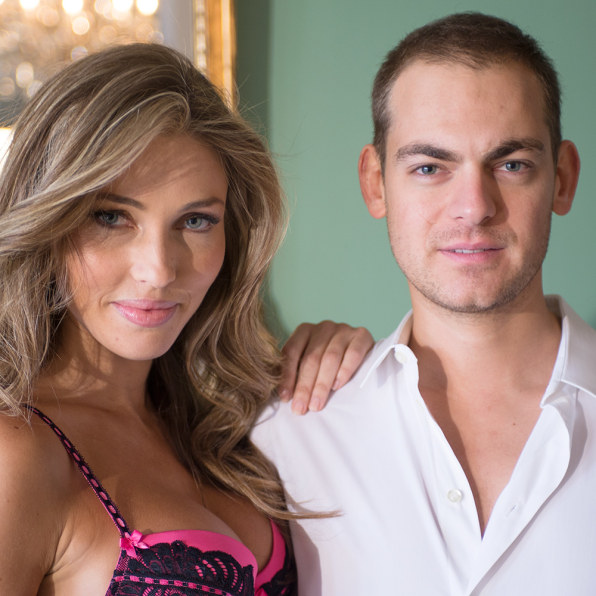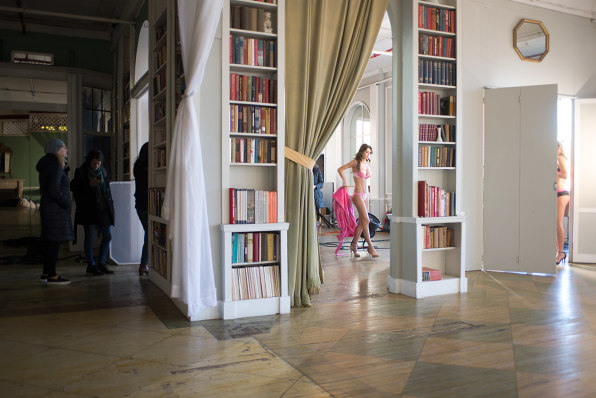Cardi B You Know What I M Saying
Sex doesn't sell, so forget the boudoir shot. Blondes don't work. Props distract. Couches are fine. Playing with hair is ideal.
Those are some of the insights the lingerie company Adore Me has learned from testing the photos of models wearing its sexy products online. For each bra, Adore Me shoots multiple versions of images to run on its website. The distinctions between the pictures might include different models wearing the same set in the exact same position, or the same model in the same set in a different position, for example. Then, like any good tech company, it tests the options to find out which one sells better.
"We see the impact of each picture in some sort of parallel process," Adore Me CEO Morgan Hermand-Waiche told me while sitting in the chilly Metropolitan building, where this month's photo shoot–shown here–took place. For every thousand people that come on the site, 500 will see picture A, another 500 will see picture B and over time, one will sell better than the other.

That practice, also known as A/B testing, happens all the time on the Internet, and elsewhere. Netflix A/B tested its queue design to maximize binging; Google A/B tested the color of its ad links to maximize clicks; the Obama campaign A/B tested its website to maximize campaign donations. While it's not all that surprising that one of the country's fastest growing retail companies uses data to improve sales, the company isn't quantifying the efficacy of shades of blue, but of human beings–each one as gorgeous as the last.
Adore Me certainly isn't the only online clothing retailer that uses A/B testing to optimize product display on its website. "I would say a large majority of online retailers are doing some level of A/B testing for campaign optimization," says Matt Helmke, the PR rep for Monetate, which provides "multichannel personalization" through A/B testing for over 300 top retail brands. Companies use A/B testing to personalize the shopping experience or test how well sales pitches work. For example, if the website knows you're female, it will show a picture of a woman wearing its product because testing has shown that's what women like.
But not all companies are as specific and methodical as Adore Me when it comes to each element of a photo. Of course, if a product doesn't sell well, any online retailer might swap the image for something else. But AdoreMe subjects all of its images to testing every single month, going as far as to test one hand position against another, and in doing so has collected a trove of intel on what works and what doesn't.

At the photo shoot, beautiful models with perfect everything glide by in stilettos. Space heaters are put out to warm the nearly nude women, while makeup artists in puffy jackets touch up their faces. The photographer, a man, has some guidelines for what works in pictures: a certain distance between the camera and the model, a specific blurriness, particular positions that sell well. Hand on hip, a popular pose among Instagrammers trying to make their arms look skinny, doesn't resonate nearly as well as a hand on the head, for example. (That slight change can double sales, according to internal research.)
Of course, not every single picture on the website can look the same, giving the photographer and his bustling bevy of assistants some creative freedom. Adore Me also wants to leave room for experimentation, since the artist's eye might result in a new pose that will test well on the site.
Despite all the directions, the shoot doesn't feel particularly calculated. The models strike various poses as fans blow in their faces. "She has rockin' cleavage, so she'll make that look good," an assistant shouts across the room.
Born in France, Hermand-Waiche studied math and computer science at Ecole de Mines, which he describes as the MIT of Paris. "Technically, my undergrad really made me a strong geek," he said. Adore Me, which he founded in 2010 after attending Harvard Business School, has A/B tested since it could afford the practice.
A/B testing takes more resources because it requires at least two of everything. At the all-day event, Adore Me photographs between 30 and 40 new looks that will debut on the site the next month. For every bra and underwear set, the company has to ensure it has enough options to test for each garment. Each month, the retailer also reshoots a handful of garments that didn't sell well on the site. Today, Adore Me is testing a new blonde model. While natural blondes make up about 16% of the U.S. population, and gentlemen have been said to prefer them, nobody wants to buy lingerie from them. So far, no one with golden locks has sold well, Hermand-Waiche says.
"Picture has a huge impact on sale when it comes to fashion," he adds, pulling his cashmere sweater over his presumably chilled hands. That's especially true for an online retailer, where buyers make decisions based on images and what they convey. For lingerie it's all the more important, Hermand-Waiche argues. "You buy the product not only for what it looks like, but for the emotions that the product conveys to you and that you want to convey through the product."
Through its research, Adore Me has found that the right model matters even more than price. If customers see a lacy pushup on a model they like, they'll buy it. Put the same thing on a model they don't, and even a $10 price cut won't compel them. Pose matters as well: the same product shot on the same model in a different posture can nudge sales a few percentage points in either direction. Another test found that a popular model can sell a more expensive version of the same garment.

The tinkering–which seems incremental–adds up, and has helped the company maximize sales. In four years, Adore Me has matched the sales of competitors like La Perla, bringing in $5.6 million in revenue, according to Inc.
But what happens when the masses dictate beauty standards? Hermand-Waiche argues that his science-based approach is more inclusive than letting a group of photographers and art directors deploy their narrow-minded, personal taste. The company uses an actual plus-size model, unlike brands like Calvin Klein that use "in-betweenies"–the clumsy term for models who don't technically fall into "plus size," which starts at size 12.
Scrolling through the site, the models could all be related–long legs, olive skin, dark hair, insanely hot.
But Hermand-Waiche denies that his site depicts only one version of beauty. "Actually, ethnicity doesn't mix and match with how it sells," he said. "We had some super strong sellers on the African American model, and we had some super bad sellers on the African American model, it was all about the way she behaves in the picture. That's what makes the beauty of the A/B testing. It doesn't cancel out an ethnicity and a genre; it's all about the emotion."
Cardi B You Know What I M Saying
Source: https://www.fastcompany.com/3038740/this-lingerie-company-a-b-tests-the-worlds-hottest-women-to-see-who-mak